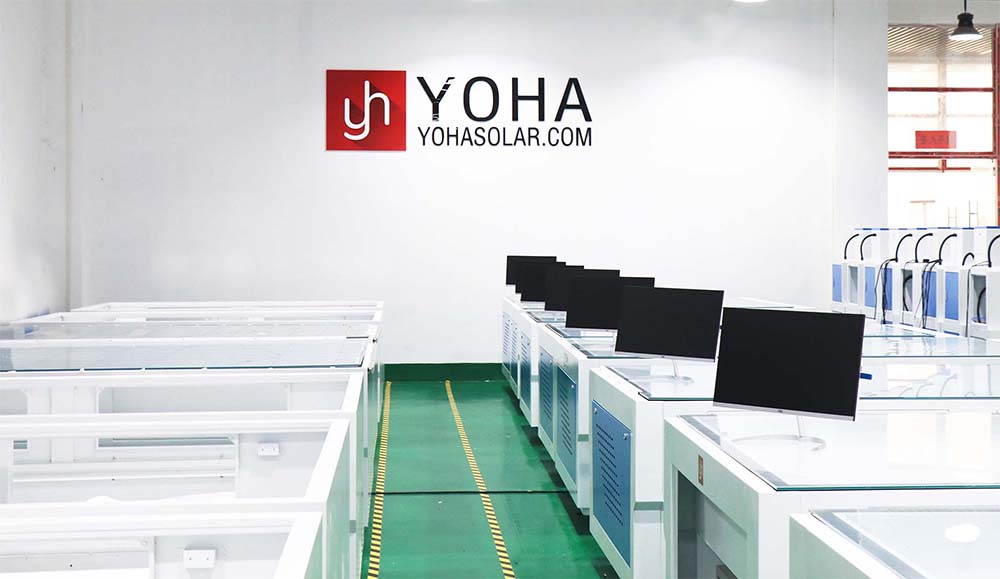Welcome to Wuhan Yoha Solar Technology Co., Ltd!
common problem
Site Map
Language:
 Chinese
Chinese
 English
English
Welcome to Wuhan Yoha Solar Technology Co., Ltd!
common problem
Site Map
Language:
 Chinese
Chinese
 English
English
In the surging wave of the rapidly developing photovoltaic industry, faced with a dazzling array of solar module products on the market, gaining an in-depth understanding of current mainstream solar panel technologies is crucial for end-users, investors, and the entire energy decision-making chain. What are the mainstream solar panel types currently on the market? What characteristics allow each to hold its ground? This article provides a systematic overview for you.
I. Monocrystalline Silicon (Mono-Si) Panels: The Efficiency Leader, Dominating the Market
Monocrystalline Silicon technology is undoubtedly the absolute mainstay of the current global PV market, holding approximately 80% market share. Its core advantages lie in exceptionally high conversion efficiency and excellent long-term reliability.
Core Technical Features: Uses the Czochralski (Cz) method to grow structurally complete, highly pure monocrystalline silicon ingots, which are then sliced into wafers. Wafers typically appear dark blue or black with a uniform surface color.
Core Advantages:
Highest Conversion Efficiency: Monocrystalline silicon cells have the highest theoretical and lab efficiency limits. Mass-produced module efficiencies generally exceed 21%-23%, with top products (e.g., using N-type technology) surpassing 24%, and labs pushing towards 25%+. This means generating more power per unit area.
Superior High-Temperature Performance: Lower power loss in high-temperature environments compared to polycrystalline silicon.
Excellent Low-Light Response: Maintains relatively good power generation capability under low-light conditions like dawn, dusk, or cloudy days.
Longer Lifespan & Warranty: Major manufacturers typically offer 25-30-year linear power output warranties with low degradation rates.
High Space Utilization: High efficiency provides a clear advantage where roof space is limited or higher installed capacity is desired.
Technological Evolution:
PERC (Passivated Emitter and Rear Cell): Significantly boosted cell efficiency through rear surface passivation and local aluminum back surface field (BSF), becoming the dominant monocrystalline technology in recent years.
TOPCon (Tunnel Oxide Passivated Contact): A leading N-type technology. Achieves excellent passivated contact by forming an ultra-thin silicon oxide layer and a doped polysilicon layer on the cell rear, offering high efficiency potential and rapidly expanding production.
HJT/SHJ (Heterojunction with Intrinsic Thin layer): Another N-type technology utilizing a heterojunction structure between crystalline silicon and amorphous silicon thin films, featuring an intrinsic amorphous silicon layer for ultimate passivation. Advantages include very high bifaciality, ultra-low temperature coefficient, no light-induced degradation (LID), and relatively simple processing steps (though cost remains higher). Market share is growing rapidly.
Application Scenarios: All scenarios demanding high power generation efficiency and space utilization, especially distributed rooftop PV and large-scale ground-mounted power plants. Among mainstream solar panel types, monocrystalline silicon firmly holds the core position due to its efficiency advantage.
II. Polycrystalline Silicon (Poly-Si) Panels: Economical & Practical, Fading into History
Polycrystalline Silicon panels once rivaled monocrystalline silicon and were a major force in the early PV market. Their wafers are cast from molten silicon, containing multiple silicon crystals with different orientations, resulting in a distinctive blue-speckled appearance.
Core Technical Features: Casting process is relatively simpler; silicon purity requirements are slightly lower than for monocrystalline.
Core Advantages (Historical):
Cost Advantage: Historically, its production cost was significantly lower than monocrystalline silicon, playing a vital role in driving grid parity for PV.
Mature and Stable Manufacturing Process.
Main Disadvantages:
Relatively Lower Efficiency: Grain boundaries impede the movement of photo-generated carriers. Mass-produced module efficiencies typically range from 17%-19%, lower than mainstream monocrystalline products.
Uneven Appearance/Color.
Slightly Inferior High-Temperature Performance & Low-Light Response compared to Mono-Si.
Market Status: With the substantial reduction in monocrystalline ingot pulling costs (especially due to diamond wire cutting) and continuous efficiency improvements, monocrystalline's cost-performance advantage became increasingly prominent. Polycrystalline silicon largely lost its dual advantages in efficiency and cost. Its global market share has sharply declined in recent years, gradually exiting the mainstream competitive stage. New installations of polycrystalline silicon panels are now rare in the mainstream market, their role largely replaced by efficient monocrystalline silicon.
III. Thin-Film Solar Cells: Unique Advantages, Differentiated Development
Thin-Film Photovoltaics employ a different technological path from crystalline silicon, depositing photovoltaic materials only a few micrometers thick directly onto substrates like glass, metal, or flexible materials. While their overall market share is much smaller than crystalline silicon (around 5%), thin-film technologies offer irreplaceable advantages in specific niches among mainstream solar panel types. Main types include:
Cadmium Telluride (CdTe):
Technical Features: Commercialized primarily by US company First Solar. Direct bandgap material with strong light absorption.
Core Advantages:
Low Manufacturing Cost Potential: Fast deposition processes and minimal material usage offer cost advantages at scale.
Excellent Low-Light & High-Temperature Performance: Low temperature coefficient, performs well in hot climates and under diffuse light.
Uniform, Aesthetically Pleasing Appearance: Large-area uniform black, high potential for Building-Integrated Photovoltaics (BIPV).
Low Carbon and Water Footprint.
Main Challenges: Conversion efficiency (~19%-20% for mass-produced modules) currently lags behind top crystalline silicon; contains cadmium (though safely encapsulated and with established recycling).
Applications: Large-scale ground-mounted plants (especially in hot regions), specific BIPV projects.
Copper Indium Gallium Selenide (CIGS):
Technical Features: Tunable material composition (adjusting Ga/In ratio) optimizes bandgap for absorbing different light wavelengths.
Core Advantages:
Flexibility Potential: Can be produced on flexible substrates (stainless steel foil, polyimide), suitable for curved or lightweight applications.
Good Low-Light and High-Temperature Performance.
High Theoretical Efficiency.
Uniform Appearance.
Main Challenges: Complex manufacturing process (involving co-evaporation/sputtering of four elements), difficulties in scaling production efficiency (~16%-19%) and controlling costs, limiting market share expansion.
Applications: Flexible portable power, specific BIPV (curved roofs, facades), consumer electronics integration.
Amorphous Silicon / Microcrystalline Silicon (a-Si/μc-Si): Once used in small electronics, but low efficiency (6%-10%) and significant light-induced degradation (Staebler-Wronski effect) led to its near elimination from the mainstream power generation market.
IV. Emerging Technologies: A Promising Future
Beyond the mature technologies above, several cutting-edge technologies in labs or early production stages show immense potential to reshape the future market:
Perovskite Solar Cells: Astounding speed of efficiency gains (single-junction lab records >26%), low material cost, solution processability, potential for flexible devices. Core challenges are long-term stability and large-area uniform fabrication. Current focus includes combining with crystalline silicon (tandem cells) or CIGS to leverage their wide bandgap for higher overall efficiency.
Perovskite/Silicon Tandem Cells: Stacking a perovskite cell (absorbing short wavelengths) atop a silicon cell (absorbing long wavelengths) to break the efficiency limits of single-junction cells (theoretical limit >40%, lab records >33%). Considered one of the most promising next-generation ultra-high-efficiency PV technologies, with numerous companies and research institutions globally accelerating development.
III-V Compound Solar Cells: E.g., Gallium Arsenide (GaAs). Extremely high efficiency (single-junction >30%, multi-junction >45%), but prohibitively expensive. Primarily used in space, Concentrator Photovoltaics (CPV), and other specialized fields.
How to Choose the Right Solar Panel Type?
Returning to the user's core concern: What are the mainstream solar panel types currently on the market? The answer clearly focuses on high-efficiency monocrystalline silicon technologies (PERC, TOPCon, HJT), which dominate absolutely due to their outstanding performance and ever-improving cost-effectiveness. Thin-film technologies (CdTe, CIGS) retain unique value in specific applications (large plants in hot climates, BIPV, flexibility needs). Polycrystalline silicon has exited the mainstream stage, while emerging technologies (like perovskite tandems) represent an exciting future.
When choosing, consider comprehensively:
Available Space & Efficiency Requirements: Prioritize high-efficiency monocrystalline silicon for limited space.
Project Location Climate: Consider thin-film or HJT (low temp. coefficient) for hot regions.
Budget: High-efficiency monocrystalline silicon (especially PERC) offers strong cost-performance.
Special Requirements: e.g., architectural aesthetics (thin-film, all-black modules), lightweight/flexibility (flexible CIGS).
Long-Term Reliability & Warranty: Prioritize mainstream brands and scrutinize warranty terms.
Conclusion
The evolution of photovoltaic technology never ceases. Gaining a deep understanding of what the mainstream solar panel types currently on the market are, along with their core characteristics, is the key foundation for grasping energy investment directions, optimizing system design, and maximizing power generation returns. High-efficiency monocrystalline silicon technology leads the present with its exceptional overall performance, while thin-film technologies serve specific niches with unique strengths. Promising emerging technologies paint a picture of a more efficient and diversified PV future. In the era of energy transition, choosing the technology path that best matches your needs is essential to unlocking the full potential of solar energy.
keywords:TOP
18086473422
MESSAGE
